101 Weather And Home Weather Station Facts & Tips You Need To Know

Often, one looks for specific answers to specific questions, especially regarding weather-related topics like home weather stations. Sometimes, though, one is not looking for anything specific but would like to browse through some random article about a general topic and, in the process, maybe stumble across something fascinating. You are in the right place.
In this article, we are going to just that. We compiled a list of 101 random tips and useful information, all related to the weather, that may just spark your interest.
To make the information more readable and organized, we categorized it into four sections to help you find what you might be looking for more quickly:
- General Weather Facts
- Important Weather Tips
- Home Weather Station Tips And Helpful Information
- Climate Facts
Below each of the 101 topics listed, a brief description will be given to explain each subject as briefly and precisely as possible. Where possible, we will provide a link to an article describing the topic in much more detail.
So have fun and read through this article any way you wish. You can literally start at any point and will be able to find some standalone piece of information you may find very interesting and helpful. Enjoy!
List Of Weather And Weather Station Facts
The following list name and summarize the 101 facts in each category before we look at each one more closely:
General Weather Facts
- 1The Weather Is And Always Will Be Unpredictable
- 2Rainfall - Definition
- 3The Difference Between Weather And Climate
- 4Heatwave - Definition
- 5Wind Chill - Definition
- 6Dry Spell (As Opposed To A Drought)
- 7Thunderstorm - Definition
- 8Jet Streams - Definition
- 9Cold Front - Definition
- 10Warm Front - Definition
- 11Low-Pressure System - Definition
- 12High-Pressure System - Definition
- 13A Cold Front Does Not Always Lead To Rainy Weather, While A Warm Front Does Not Always Lead To Dry Weather Conditions
- 14Hurricanes, Typhoons And Tropical Cyclones - All Essentially One-And-The-Same Weather System
- 15The Earth Is Struck By Lightning A 100 Times Every Second
- 16The Top Speed At Which Raindrops Can Fall is 18 MPH
- 17Coldest And Hottest Weather Recorded
- 18Fog Does Not Contain As Much Moisture As We May Think
- 19The Country Most Affected By Tornadoes Are The USA
- 20Dew Point, Relative Humidity And Comfort Level
- 21The Windiest Place On Earth
- 22Hail, And How It Is Formed
- 23Vertical Structure Of Earth's Atmosphere
- 24Barometric Pressure - Definition & Measurement
- 25Wind - Definition & Development
- 26Trade Winds - Definition & Development
- 27What Causes A Ring/Halo Around The Moon
- 28What Is Virga And How Does It Work?
- 29What Causes The Multi-Colored Ring Around The Sun
- 30Contrails: What They Are And How They Are Formed
- 31Supercells: Powerful And Destructive
- 32The Substantial Weight Of Rain
- 33The Highest Clouds In Our Atmosphere
- 34The Smell Of A Rain
- 35The Effect Of Lightning On Plant Life
- 36The Unique Display Of Nacreous Clouds
- 37The Shape Of a Raindrop
- 38Thunderstorms Can Be The Result Of Human Activity
- 39Wind And Sun As Powerful Sources Of Renewable Energy
- 40Raindrops Are Not Always Made Of Water
- 41Weather Patterns On Neighboring Planets
- 42The Definition Of A Monsoon And How It Is Formed
- 43The Cause Of A Ring/Halo Around The Sun
- 44What Are Weather Balloons And What Do They Do?
- 45The Effect Of Climate Change On Animal Life
- 46Most Severe Weather Extremes The Human Body Can Survive
- 47Why We Feel More Uncomfortable In Humid Weather
- 48Can Extremely Hot Weather Really Melt Roads?
- 49What Exactly Is The Ozone Layer And How Does It Protect Us
- 50Using Waves & Lightning As Renewable Energy Source
- 51Cloud Seeding And Other Attempts To Make It Rain
- 52The Effect Of Weather On Your Mood
- 53Man-Made Attempts To Affect The Weather
- 54Tornadoes On Mars?
- 55Why The Sky Is Blue (Seriously...)
- 56It Is Literally Raining Fish And Frogs
- 57Meteotsunami (Or Meteorological Tsunami)
- 58Frost Flowers in the Arctic
- 59"Fog Tsunamis" - Nature's Sense Of Humour
- 60Asperitas Clouds - More Bark Than Bite
- 61Hailstones CAN Be Fatal And Kill You
- 62The Hidden Dangers Of Black Ice
- 63Can Thunderstorms Damage Airplanes?
- 64Can Hurricane Sized Waves Sink A Large Ship?
- 65Impact Of The Weather On A Country's Economy
- 66How Temperature & Rainfall Affects The Weathering Of Rocks
- 67The Benefits Of Living In A Dry Climate
- 68Does The Moon Affect The Weather?
Important Weather Tips
- 69What To Do When Caught Outside During A Lightning Storm
- 70What To Do When A Tornado Strikes
- 71How To Protect Your House From Lightning
- 72What Not To Do When A Tornado Strikes
- 73What To Do During A Thunderstorm
- 74How To Predict The Weather Using Nature
- 75What To Do In A Heat Wave
- 76How To Survive Extreme Cold Weather Conditions
- 77Using Clouds To Tell Future Weather Events
- 78Steps To Take Against Monsoon Dangers
- 79Do Not Be Fooled By A Hurricane's Downgraded Strength
- 80What To Do When Weather Changes While On A Boat
Home Weather Station Tips And Helpful Information
- 81Always Consider Height When Placing Your Home Indoor Weather Station
- 82Choose Your Room Where Your Indoor Weather Console Will Be Placed Very Carefully
- 83Always Place Your Outside Sensor Array High Enough From The Ground Surface
- 84The Amount Of Weather Sensors Do NOT Determine The Quality Of Your Home Weather Station
- 85Do NOT Rely Solely On Your Personal Weather Station's Forecasts For All Your Local Weather Information
- 86Avoid Using The Default Settings When Installing An Advanced Home Weather Station
- 87Never Blindly Follow The Claimed "Maximum Wireless Distance" Between Your Indoor Base Station & Outdoor Sensors.
- 88Be Careful Where You Place Your Indoor Display Console
- 89Place Your Sensor Array Far Enough Away From A Large Solid Structure
- 90Don't Place Your Weather Station Close To A Body Of Water, Or Right In The Middle Of Some Lush Green Bushes
Climate Facts
- 91What Is Climate Change?
- 92Yes, Climate Change Is Real
- 93The Vital Role Of Climate In Soil Formation
- 94Climate Affects Agriculture And The Fishing Industry
- 95The Important Relationship Between Climate And Vegetation
- 96Climate And Geography
- 97Climate Change And Heat
- 98Climate Change And Rainfall
- 99Climate Does Have An Effect On Life Expectancy
- 100Climate Is Not Weather
- 101Never Stop Learning
With all the facts, general information, and tips listed, one can now take a closer look at each individual one.
General Weather Facts
1) The Weather Is And Always Will Be Unpredictable
This why the poor weather forecaster gets it so horribly wrong sometimes, and meteorologists and weather services are so often blamed and considered "worthless."

There literally are thousands of variables influencing weather on a local and regional scale, and most of them can change in a very short period of time. Just mentioning most of them and their influence will necessitate the writing of an encyclopedia.
This is why national weather services use supercomputers filling entire buildings, just busy processing all these variables and other information received from all over and above the planet, with the single goal to be able to accurately and reliably make short and long-term weather and climate forecasts.
But the fact is, the weather will remain forever unpredictable, and as soon as we think we got it figured out, it will change the rules or throw in a new variable.
But the fact is, the weather will remain forever unpredictable, and as soon as we think we got it figured out, it will change the rules or throw in a new variable.
So next time the weather forecaster gets it very wrong, take it easy on him/her. They are doing their best against a formidable foe.
2) Rainfall - Definition
Rainfall is the amount of precipitation (water in its liquid form) measured in a specific area over a set period of time and is measured by a rain gauge.

It occurs after the air becomes saturated with water vapor and is not able to further hold the water in its gaseous state, which leads to condensation and the formation of water droplets.
Microdroplets combine to form bigger water droplets, which keep growing until it becomes too heavy to be held up by winds in the cloud formation and fall to the ground.
Read more about rainfall, and also precipitation in general, in this article.
3) The Difference Between Weather And Climate
Weather can be seen as the atmospheric conditions at a specific point in time over a specific region. It measures specific weather variables over a fairly small period of time.
Climate, on the other hand, is measured over a much longer period of time (at least 30 years or more). It can be best explained as the average of weather conditions at a specific location, determined over time.
Climate helps you to determine future weather tendencies, for example, what atmospheric conditions to expect during certain seasons in a specific region. (For example, what the weather is normally like in February in New York.)
Read more about the difference between the weather and climate in this article.
4) Heatwave - Definition
A heatwave refers to a period of prolonged exceptionally hot weather, often accompanied by high humidity levels. It is often determined when compared to the hottest average temperatures from the region during the same period measured during previous seasons.
There is obviously a lot more to a heatwave than this simple explanation. If you would like to find out more, you can get it in this article.
5) Wind Chill - Definition

Wind chill (or wind chill factor as it is more commonly known) refers to the phenomena where we experience the temperature around us to be much colder than it actually is.
This is caused by the wind blowing the surrounding cold air directly against you, making you experience colder temperatures than a thermometer may suggest.
6) Dry Spell (As Opposed To A Drought)
A dry spell can be defined as a sustained period of dry weather with lower water and soil moisture levels due to a lack of the average expected rainfall.
A region with significant lower rainfall figures during its rainy season, compared to that of previous seasons, can be regarded as experiencing a dry spell.
7) Thunderstorm - Definition
Thunderstorms can be described as fairly short-live and violent disturbances in the weather, normally associated with lightning and thunder (the sound produced by lightning), strong winds, heavy rains, and sometimes even hail.
They are normally associated with a sudden buildup of cumulonimbus clouds. Very often, they are also the result of the development of a powerful low-pressure system.
You can find out more about thunderstorms and their development in this article.
8) Jet Streams - Definition
Jet streams are defined as long narrow bands of strong winds, blowing at high velocities above the earth's surface, normally found in the upper troposphere at heights of 9 to 16 kilometers (30 000–52 000 feet) above sea level.
There are four major jet streams present above the earth's surface, and they all have a huge influence on the global climate and the formation of various weather systems.
9) Cold Front - Definition
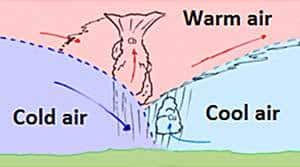
A cold front occurs when the leading edge of a large body of cold air moves into a region of warmer air. The boundary between these two air masses is called a cold front.
A cold front is usually associated with stormy weather conditions, including wind, rain, clouds, and potentially thunderstorms.
10) Warm Front - Definition
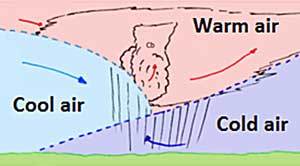
A warm front occurs when the leading edge of a large body of warm air moves into a region with cooler air. The boundary where these two air masses meet is called a warm front.
A warm front is normally associated with slow-moving stratus-type clouds producing light rains for a sustained period of time. (This type of rain is welcomed and preferred in the agricultural sector due to its soft and persistent nature).
Read more about the difference between a cold and warm front in this article.
11) Low-Pressure System - Definition
A low-pressure system is a mass of air which weight is significantly lower (or there is more space between the molecules present in this volume of air) than that of the air in the surrounding areas.
It is typically the result of air rising from the surface of the planet into the atmosphere, leaving an area of low pressure at the surface. The rising air is caused by one of two different processes: Wind Divergence Aloft or Thermal Lows.
You can read more about its development and characteristics in this article.
12) High-Pressure System - Definition
A high-pressure system is a mass of air which weight is significantly more (or there is less space between the molecules present in this volume of air) than that of the air in the surrounding areas.
Simply put, a high-pressure system occurs where the atmospheric pressure on the earth's surface is higher than that of surrounding areas.
You can also read more about its development and characteristics in this same article.
13) A Cold Front Does Not Always Lead To Rainy Weather, While A Warm Front Does Not Always Lead To Dry Weather Conditions
The word "cold" is very often mentioned in the same breath as wet and rainy weather, while the word "warm" is mentioned just as often in the same breath as dry and pleasant weather conditions.
It actually happens so often that it resulted in an almost unconscious tendency by most people to automatically associate cold with wet and warm with dry weather conditions. It is completely normal, so you cannot really be blamed for making such an assumption.
To put the record straight, both cold and warm fronts have the potential to bring cloudy and rainy weather with them. Their characteristics and the impact they have on their environment are what sets them apart, however.
The arrival of a cold front is normally very abrupt, accompanied by heavy rains and stormy weather conditions, including strong winds and thunderstorms, which normally moves very quickly and can dissipate as quickly as it arrived.
(This dramatic and violent nature of cold fronts helped establish this strong association many people have formed between cold fronts and stormy wet weather.)
A warm front, on the other hand, takes much longer to build up as moves much slower than a cold front. It is also characterized by a light but much more sustained rainfall, which can last for several hours to even days.
For the purpose of this article, it is not necessary to examine these two systems in much more detail. If you are interested, you can read more in-depth information in this article.
14) Hurricanes, Typhoons And Tropical Cyclones - All Essentially One-And-The-Same Weather System
It can be very confusing when weather forecasts refer to different devastating storm systems around the world, and randomly use terms like "hurricanes, typhoons, and cyclones.
Luckily there is a fairly simple answer to this complex-looking question...
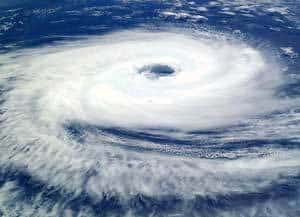
They are all one and the same type of storm!
So why all the different names? Luckily, there is also a fairly simple answer for this one as well, and it's all got to do with location.
The term "hurricane" is used when the weather system originates over the Atlantic Ocean, the Caribbean, or the Northeast Pacific Ocean.
The term "typhoon" is used when the weather system originates over the Northwest Pacific Ocean. The term "cyclone" is used when the weather system develops over the South Pacific Ocean or the Indian Ocean.
"Tropical Cyclone" is the umbrella term used by meteorologists to describe all forms of these storms, from tropical depressions and tropical storms to hurricanes and typhoons. (All these storm systems originate over the warm waters of the oceans in tropical and subtropical regions.)
And that is really all there is to it when it comes to the different names given to what is basically the same type of storm system.
There are obviously some small differences in their characteristics, but not really of much importance in the context of this article. I dedicated a complete article to the subject of hurricanes/typhoons. If you are interested, you can read all about them in this article.
15) The Earth Is Struck By Lightning A 100 Times Every Second
We often think of lightning as something special and extraordinary, especially for those of us who don't experience it very often.
They are, however, a lot more of a common occurrence than we might think. In fact, as the heading already stated, around the globe, there are about a hundred lightning strikes every second.
Common or not, nothing can diminish the spectacle of a powerful lightning display. Nor should its power and reach ever be misjudged or taken lightly.
Not only is the heat around a bolt of lightning five times hotter than the surface of the sun, the power of one lightning bolt is estimated to contain up to a billion volts of electricity.
16) The Top Speed At Which Raindrops Can Fall is 18 MPH
Considering how loud the rain sounds as it hits the roof of your home or trees in the garden during a heavy downpour, it is easy to imagine how fast these raindrops must be traveling.
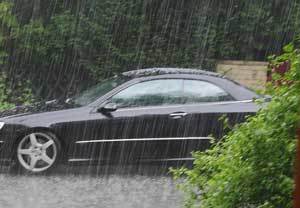
Not as fast as you might think, though. The maximum speed at which a raindrop can fall is actually only 18 mph (29 km/h). This is a result of both gravity and drag.
Naturally, once a raindrop is formed, gravity pulls it to the ground. As it travels to the ground it starts to accelerate. As it accelerates, it is met by resistance from the air, called drag, which slows down the speed of the raindrop until it falls at an average speed of 18 mph.
This is under ideal conditions. When raindrops are caught in strong hurricane winds of more than 100 mph, it can easily be blown horizontally at much higher speeds.
17) Coldest And Hottest Weather Recorded
Most of us think it's freezing when the temperature drop below 0° Celsius (32° Fahrenheit). Similarly, we think it's very hot when temperatures rise above 35° Celsius (95° Fahrenheit).
What if I tell you that the coldest temperature ever recorded was -89.2° Celsius (-128.5° Fahrenheit)? Well, this actually happened on 21 July 1983 in Vostok, Antarctica.
Not to be outdone when it comes to extremities, Greenland Range in Death Valley, California, recorded a maximum temperature of 56.7°Celsius (134° Fahrenheit) on 10 July 1913.
I will admit that this is little conciliation for those of you who either get cold or hot very quickly. Just try and remember, it really could have been a LOT worse.
18) Fog Does Not Contain As Much Moisture As We May Think
Many people, especially those living near the coast in colder regions of the world, may often experience fog. Any of you who ever got caught in thick fog while commuting in your car will be very aware of how unsettling and unpredictable this experience can feel.

The inability to see more than a few feet ahead of you while being on the move, not knowing what to expect, can be a terrifying experience. You will be forgiven for thinking that the air must be completely saturated with moisture under these circumstances.
However, a cubic mile of fog contains less than a gallon of water, not nearly as much as you would expect when experiencing a "wall of fog" first hand.
What makes the fog seem so dense and impenetrable is partly due to the fact that there are hundreds of thousands of water microdroplets filling the air. They all act as little mirrors, reflecting light instead of letting it through.
You can imagine how difficult it will be for any light to pass through this mass of microdroplets, with all of them reflecting and bouncing the light, hitting them off each other, and back to you.
Read all about the difference between fog and mist in this article.
19) The Country Most Affected By Tornadoes Are The USA
Outranking any other country by averaging around 1200 tornadoes per year, the United States Of America sees more tornadoes than most other countries combined.
There is a reason why this happens so often, though. An area in Central America, commonly referred to as Tornado Alley, has both the typography and weather conditions ideal for the formation of tornadoes.
The relevantly flat service of the Great Plains in Central America, combined with the cold air moving in from Canada colliding with the warm air from the Gulf Of Mexico, forms the perfect recipe for the formation of a supercell.
And it is within a supercell that tornadoes are created through a series of processes. You can read an indepth report on tornadoes, how and where they are formed, as well as their characteristics in this article.
20) Dew Point, Relative Humidity And Comfort Level
Simply put, dew point is the temperature at which the air is fully saturated with water vapor. If the temperature drops any further, condensation will take place, and small drops of water will form.
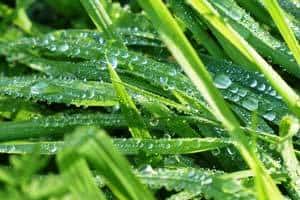
As the name suggests, relative humidity measures the amount of moisture in the air relative to the air temperature at a specific location. (This is the most common way used to calculate humidity, unlike absolute humidity, which measures humidity regardless of temperature.)
Now you would wonder what all of this has to do with comfort level. Well, most of us know the uncomfortable sticky, and exhausting feeling we experience during hot and humid weather conditions.
What may come as a surprise, though, is that dew point, and not relative humidity, is the more accurate means of measuring the level to which we are experiencing this discomfort.
This may all sound a bit confusing, I know. If you would like to get more answers and better understand the process, you read more about in this article.
21) The Windiest Place On Earth
A while ago, I wrote an article about gale-force winds and how many cities, like San Francisco and Cape Town, often experience these prolonged strong winds. I stated how these strong gusty winds, occurring during otherwise clear and sunny days, can make life miserable for these cities' inhabitants.
After stumbling across the following facts, though, I think I should reconsider my attitude towards these gale-force winds and stop complaining about them so much. The reason for this will become evident soon.
Commonwealth Bay, Antarctica, has been named the windiest in the world (and is even recognized by the Guinness Book of Records). Wind speeds of up to 200 mph (322 km/h) have been recorded, and the region has an average annual wind speed of 50 mpg (80 km/h)!
I don't think I, or anyone else, will try and challenge these claims, or try and go find out for ourselves. You will now understand why I am considering taking a less critical approach to these "small little breezes" that are so persistent in our windy cities.
Read more about Commonwealth Bay, as well as the top 11 windiest locations in the world in this article.
22) Hail, And How It Is Formed
Hail is the result of water drops that are caught in the updrafts of a storm cloud. As they travel up into sub-zero temperatures, they freeze and form balls of ice.

These balls of ice collide with supercooled water drops at sub-zero temperatures. As soon as a supercooled water drop touches the surface of a ball of ice (or ice crystal), it freezes, causing the hailstone to grow.
The size to which a hailstone can grow depends on the strength of the updrafts and the number of times the hailstone can be lifted up into sub-zero temperatures and collect more supercooled water drops.
Once the strengths of updrafts can no longer support the weight of the hailstone, gravity takes over, and the hailstone falls to the ground.
23) Vertical Structure (Layers) Of Earth's Atmosphere
The air above the ground can be divided into different layers. The best way to think of this is to use the analogy of an onion. Just like an onion, which has different layers that can be peeled away, the earth's atmosphere also consists of different layers of air.
There are five main layers surrounding the earth, called the:
- Troposphere
- Stratosphere
- Mesosphere
- Thermosphere
- Exosphere
The troposphere starts at the planet's surface and reaches a maximum height of around 16 km (10 miles). It is in this layer where most life takes place and is characterized by a drop in temperature as altitude increases.
A thin layer of air called the tropopause forms the upper boundary of the troposphere.
The stratosphere can be found above the tropopause at a height of 16 km (10 miles) and reaches a maximum height of 50 km (31 miles). There is very little change in temperature in the stratosphere, but the small change shows a rise in temperature with an increase in height.
A layer of air called the stratopause forms the boundary between the stratosphere and mesosphere.
The mesosphere starts at a height of 50 km (31 miles) and reaches a maximum height of 80 km (50 miles) above the earth's surface. It is the coldest of the five layers, with temperatures dropping as low as -100° Celsius (-148° Fahrenheit).
It is also the layer where most meteorites burn up as they enter the earth's atmosphere. (Seen from the surface as "shooting stars.")
Another layer of air called the mesopause forms the boundary between the mesosphere and the thermosphere.
The thermosphere starts at 80 km (50 miles) and reaches heights of up to 640 km (398 miles). Temperatures rise steeply in this layer, reaching temperatures of well above 1000° Celsius (1832° Fahrenheit).
The exosphere is the outermost layer of the planet and extends for thousands of miles into space with no clear border between the end of Earth's atmosphere and the start of space.
You can find an in-depth discussion of the Earth's five layers in this article.
24) Barometric Pressure - Definition & Measurement
All atmospheric air contains weight. And even though it may seem invisible, it contains all kinds of molecules and particles like nitrogen, oxygen, carbon dioxide, and argon, all of them adding weight to the air.
Barometric (atmospheric) pressure simply refers to the force per unit area exerted by the weight of the atmosphere.
The instrument used to measure atmospheric pressure is called the barometer, developed by Evangelista Torricelli three centuries ago. In principle, it works by balancing the atmosphere against a column of mercury.
The two most common types of barometers are the mercurial and aneroid barometer. Although they are still used in certain applications today, the vast majority of modern barometers are digital, using different kinds of material to measure pressure.
Read more about how a barometer works, as well as the different types of barometers in this article.
25) Wind - Definition & Development
Wind can be defined as the flow of air from an area of high pressure to an area of low pressure (to restore the balance in air pressure and reach a state of equilibrium).

The sun heats up the surface of the planet. Different areas of land and sea respond differently to solar radiation and heat up at different speeds. An area of landmass, for example, will heat up more quickly than the surface of the ocean.
As a result, the air over the land expands more quickly, creating an area of low pressure. The air over the ocean takes much longer to heat up, and the air expands more slowly, creating an area of higher pressure than the air mass over land. As a result, the wind will blow from the ocean (high-pressure) towards the land (low-pressure).
The strength of the wind is determined by the pressure gradient (the distance between the high and low pressures), indicated by isobars on a map. The steeper the pressure gradient (the closer together the high and low pressures are), the stronger the wind.
Find out more about the different types of wind and their characteristics in this article.
26) Trade Winds - Definition & Development
Trade winds refer to the winds blowing towards the equator, in the Northern Hemisphere from a northeasterly direction, and in the Southern Hemisphere from a southeasterly direction.
It is the result of the Coriolis Effect, which is caused by the rotation of the earth.
Trade winds originate at the two high-pressure belts, called the horse latitudes at both 25° and 30° north and south of the equator. The high-pressure belts force the air to the low-pressure belt (called the doldrums), next to the equator.
From here, the air is forced high into the air and move towards the poles. As a result of the Coriolis Effect, the air doesn't move directly north but is deflected in an easterly direction as it moves toward the poles.
In the polar regions, the air is cooled down and sinks back to the surface where it circulates back to the equator in the direction described in the introduction, completing the cycle of air movement.
27) What Causes A Ring/Halo Around The Moon
We often look at the full moon at night and notice a hazy looking ring (or halo) around it. It looks striking, especially when the conditions are just right.

Rings around the moon are nothing more than the refraction & reflection of the moonlight by millions of ice crystals present in cirrus clouds drifting at a height of 20 000 feet (6000 meters) or more above the earth's surface. Depending on where you stand, the ice crystals need to refract the light from the moon just at the right angle in order to see it. (This is why the circle is not visible to everyone. It all depends on your geographical location.)
You can read more about this phenomenon in this article.
28) What Is Virga And How Does It Work?
Virga can be seen as the magician of precipitation. Simply put, this type of rainfall hangs underneath a cloud but disappears before it reaches the ground.
This often happens when "rain" falls from high altitudes in the form of ice crystals. The friction and heat in the air cause it to melt and evaporate as it falls to the ground.
If you need more information about virga, you can find it in this article.
29) What Causes The Multi-Colored Ring Around The Sun
Just as rings are formed around the moon, rings around the sun are nothing more than the refraction & reflection of the sunlight by millions of ice crystals present in cirrus clouds drifting at a height of 20 000 feet (6000 meters) or more above the earth's surface.
Very much like the shape of raindrops causing the different colors in a rainbow to appear, the faceted (specifically six-sided) shape of ice crystals not only refract the light of the sun but also breaks it up into its individual colors.
This is why some rings around the sun appear to have a red tint on the inside and a bluish hue on the outside. (With the different colors of the rainbow vaguely visible in between.)
30) Contrails: What They Are And How They Are Formed
Contrails are the thin straight clouds we see high up in the atmosphere. Unlike most other weather phenomena, they are man-made and normally caused by airliners and other aircraft.

As an aircraft travels through the freezing cold weather of the upper atmosphere, the ice crystals in cirrus clouds are sucked up by the plane's engines. The warm water vapor that leaves the engine's exhaust immediately condensates and forms small water droplets.
As a result, these now-familiar long narrow trails of clouds are formed. Depending on altitude and humidity, they can last from a few seconds up to a few hours.
31) Supercells: Powerful And Destructive
A supercell can be classified as a large slow-moving thunderstorm, characterized by very strong and deep rotating updrafts (mesocyclone). They are by far the most deadly form of this type of storm system.
These storm systems are so big that it is not uncommon for cloud formations to reach heights of 55 000 - 70 000 feet (16 000 - 21 000 meters). Apart from the strong updrafts in these clouds, supercells are also saturated with moisture. This leads to extreme weather conditions.
Not only are they one of only a handful of storm systems capable of producing tornadoes, but they are also responsible for extreme weather conditions like severe thunderstorms & lightning, heavy downpours, and large hail storms.
These severe weather conditions can last for up to 4 hours. This can potentially result in massive devastation on the ground in the area directly affected by the storm.
32) The Substantial Weight Of Rain
When we think of rainfall, weight is not exactly the first thing that comes to mind. You might want to think twice if you take the following facts into consideration:
The actual weight of rain is quite substantial. On an acre of land, 1 inch of rain measures around 226 000 pounds (102 512 kg). It is also estimated that approximately 1 billion tons of rain fall on the earth every single minute.
This will help to explain why the effects of ocean activity are so powerful and why flooding is considered to be the most dangerous part of any storm system, including hurricanes.
33) The Highest Clouds In Our Atmosphere
If you were under the impression that cirrus clouds, consisting purely out of ice crystals, are the highest clouds in our atmosphere, you wouldn't be far off, but not entirely correct. After all, they "only" appear in the upper troposphere and lower stratosphere.
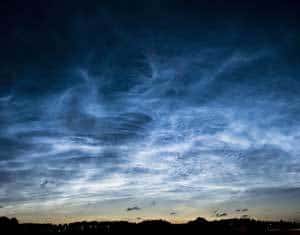
Noctilucent clouds (also referred to as night-shining clouds) are actually the highest clouds in the world and can be found in the mesosphere. It means altitudes in the region of 50 miles (80 kilometers) above the earth's surface.
These clouds appear at high latitudes, around 45 - 60 degrees north or south, and can mostly be found in polar regions, specifically countries like Scandinavia, Russia, and Canada.
At this high altitude, they consist completely out of ice crystals. They have a streaky and wave-like appearance, with a pale blue color (which is the result of the absorption of ozone in the path of sunlight illuminating the cloud.)
Noctilucent clouds are most visible about 2 hours after sunset and display a stunning blue glow, which provides a beautiful contrast against the dark night sky as sunlight illuminates the cloud surface.
34) The Smell Of A Rain
Let me first clarify before I get dragged to court by the fact-checkers. Rain and raindrops do not have any smell or aroma themselves.
Yet, most of us are familiar with that "fresh" smell in the air that accompanies or directly following a rain shower. If not rain, what and why are we actually smelling?
When it rains, geosmin (an organic compound) with a distinctly earthy flavor, consolidates with plant oils that are released from the soil, which creates the distinctive natural aroma and scent that hangs in the air after a rain shower, referred to as petrichor.
So it is neither your imagination nor the actual smell of rain, but the direct result of rain that is responsible for this distinctive pleasant aroma.
35) The Effect Of Lightning On Plant Life
Lightning is normally associated with devastation. In most cases, this is true. In some instances, however, it can have both a positive and negative effect on flora.
When it comes to trees, it is mostly bad news. When lightning hits a tree directly, the electrical current travels below the bark of the tree where there is more moisture (as moisture conducts electricity very effectively).
This inner layer is instantly heated and expands, causing the bark to be blown off the tree, and in some cases, for the wood to split. As a result, this will cause the whole tree to die.
For many plants, a process called nitrogen fixation is vital for them to absorb nitrogen, which is essential for promoting their growth. The extreme heat from lightning causes nitrogen to combine with oxygen, causing nitrogen oxides to form. In turn, it combines with the moisture in the air to provide plants with nitrate-rich water.
36) The Unique Display Of Nacreous Clouds
Nacreous clouds (also called mother-of-pearl clouds) are very rare but so spectacular that you won't easily forget the breathtaking sight.

They usually appear after sunset or before dawn and are lit up by the sun from well below the horizon. Nacreous clouds mostly appear in polar regions at high altitudes in the stratosphere at around 15 000 - 25 000 meters (49 000– 82 000 feet.)
The spectacular iridescent color display is a result of the small ice crystal scattering and refracting the light as it is hit by the sunlight from below the horizon.
You can learn more about nacreous clouds in this article.
37 The Shape Of a Raindrop
We are all very familiar with the shape of a raindrop in the form of a teardrop. The only problem with this assumption is that it is an entirely false representation of what the real shape of a raindrop is.
In reality, its shape is more spherical or elliptical, depending on the size of the raindrop, as well as two forces working against each other. They are the air pressure pushing against the raindrop and the surface tension of the raindrop itself.
Raindrops vary in size from 0.1 to 10 mm in size. The smaller raindrops have a mostly spherical shape. As they increase in size, they become more flat and elliptical. Once they exceed 4.5 mm, they become distorted and almost represent the shape of a parachute.
Get more in-depth information about the shape and formation of a raindrop in this article.
38) Thunderstorms Can Be The Result Of Human Activity
Although the vast majority of thunderstorms occur as a result of natural phenomena, there are a few instances where man-made actions are, in fact, the impetus for a few of these storms.
Comprehensive studies indicate that the heat generated by big cities and the resulting increase in temperature in and around them (as a result of the Urban Heat Island effect) can trigger thunderstorms that would not have occurred in their absence.
Another human creation, the warm, unstable air produced by the cooling stacks of nuclear power plants, has shown some evidence of also triggering smaller types of thunderstorms.
39) Wind And Sun As Powerful Sources Of Renewable Energy
Most of you already know how solar energy from the sun is used as a renewable power source, growing exponentially by the year. From solar panels on the roof of a domestic home to solar farms with thousands of solar panels able to power a small town, it has become a widely-used and welcome source of energy.
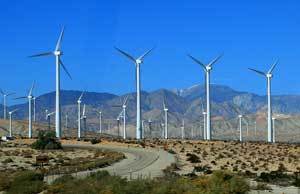
The power of wind energy can and is already being harnessed on an increasing basis. Especially in areas experiencing substantial wind activity all year round, the use of wind farms is also on the increase. Even offshore wind farms are growing in popularity as the naturally occurring land & sea breezes are being put to use.
Just to give you an indication of the potential energy that can be harvested from the wind, the electricity produced by the largest wind turbine (found on wind farms) is enough to power 600 homes. The smaller wind turbine sometimes found in large backyards can easily power your home or small business.
The bottom line is that these elements of weather are not just something we experience, but in many cases, valuable resources that we can explore and use.
40) Raindrops Are Not Always Made Of Water
This one is thrown in more for entertainment purposes and is not information that can be used in practice. (Except if interplanetary travel becomes very affordable and the ability to survive in extremely hostile environments becomes possible.)
Like on earth, rain also falls on other planets, with a slight difference. Instead of water, sulfuric acid rains on planets like Venus. Methane pours from the skies on Titan (Saturn's largest moon), and Jupiter experience the occasional "refreshing" liquid helium rain shower.
And last but not least, on a planet about 5 000 light-years away, scientists discovered raindrops made of iron.
On these planets, if the natural environment won't kill you, the rain definitely will. Maybe we should keep it in mind next time we want to complain about the weather.
41) Weather Patterns On Neighboring Planets
After reading the previous point, you know that "rain" is not unique to earth. Well, you probably will not be too surprised then if you learn that some other familiar weather phenomena on earth occur on other planets as well.
The only significant difference is that the size and force of the weather on most of our neighboring planets make earth's most extreme weather seem like a mere ripple in a pond.

Winds of various speeds occur on many of the planets in our solar system. With wind speeds on Saturn reaching 1800 km/h (1118 mph), and those on Neptune topping even that by reaching speeds of 2100 km/h (1305 mph), I have a suspicion Earth may not be quite in the same league.
This suspicion is confirmed when we look at storm systems on other planets. Just like the Earth, they also experience severe storms. They are, however, "slightly" bigger in size and duration. The red spot that has been a very noticeable feature since man started observing the planet Jupiter is nothing more than a huge storm, about twice the size of the Earth. And if that doesn't make much of an impression, the fact that it has been raging for at least 300 years should do the trick.
I think when it comes to extreme weather events, we should rather not try and compare ourselves with our neighbors in the solar system.
Learn more about extreme weather on other planets in this article.
42) The Definition Of A Monsoon And How It Is Formed
A monsoon is the weather phenomenon that forms over India and Southeast Asia during the warm summer months, bringing massive torrential rains to the subcontinent.
It is caused by a change in wind direction, as southerly winds move from the high-pressure system over the warm Indian and Western Pacific Oceans. It picks up large volumes of moisture from these warm ocean water as it moves north towards the low-pressure system present over the continent.
When the air reaches land, it starts to rise and cools down as it gains altitude. The cooler air can no longer hold the moisture, and condensation takes place, leading to large-scale rainfall over the region.
In turn, the cooler air moves back over the ocean. This completes the cycle of airflow that creates the structure of a monsoon.
(Although monsoons are mostly associated with India and Southeast Asia, It has to be noted that monsoons also occur over the Southwestern United States as well as West Africa.)
43) The Cause Of A Ring/Halo Around The Sun
Sometimes we look at the sun during different times of the day and notice a hazy but spectacular looking ring around it. We often see the same phenomenon around the moon during the night, but most of us have no idea what it really is.
Colorful rings around the sun are nothing more than the refraction & reflection of the sunlight by millions of ice crystals present in cirrus clouds drifting at a heights of 20 000 feet (6000 meters) or more above the earth's surface.
Depending on where you stand, the ice crystals need to refract the light from the sun just at the right angle in order to see it. (This is why the circle is not visible to everyone. It all depends on your personal location.)
44) What Are Weather Balloons And What Do They Do?
Most you already heard about weather balloons. We sometimes hear them mentioned during weather forecasts, and they have even been mistaken for UFO "sightings" numerous times, causing some controversy. But what exactly are they, and what is their purpose?
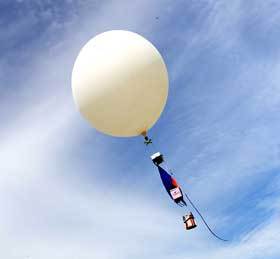
A weather balloon is a specific type of balloon, designed to carry meteorological equipment high up into the upper troposphere or lower stratosphere (up to 100 000 feet or 30 480 meters), to provide meteorologists with valuable data about the temperature, humidity, atmospheric pressure, and other variables.
This data, transmitted back to earth via radio transmitters, are used by meteorologists to analyze current and forecast future weather condition.
It is about 6 to 8 feet (1.40 to 2.40 meters) in diameter, made of strong, flexible latex, with the weather instruments (contained in a radiosonde) attached to the bottom.
You can read all about weather balloons in this article.
45) The Effect Of Climate Change On Animal Life
If you think us humans are having a rough time adjusting to extreme weather conditions, spare a thought for our friends in the animal kingdom. They may be in for a rough ride ahead.
It's not all bad news, though, especially if you are a male sea turtle in the Great Barrier Reef. A recent survey showed that 86.8% of all turtles in the area are now female. This is because the sex of a sea turtle is determined by water temperature while they are still in their eggs.
Warmer water favors female turtle development, while colder water encourages male turtles development. The global rise in ocean temperatures can clearly be seen in the domination of female sea turtles in this area. It may spell trouble for future reproduction and survival of the species, though.
Bats, especially the gray-headed flying foxes, are literally dropping out of the sky during heatwaves in Australia. (The heat disorientates them as it affects their brains.) Some literally die while still clinging onto branches in the simmering heat.
In the Northern Arctic Region, it is the shocking decline of the polar bear population that really should be sounding the alarm. It is estimated that the polar bear population has dropped by a devastating 40% between 2001 and 2010.
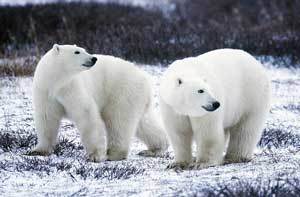
This is a direct result of the increasing breakup of the icecaps do to the global rise in temperature. Polar bears need this floating ice for both feeding and breeding. As the ice is breaking up, polar bears are starting to move more south in an attempt to survive, but this is forcing them out of their natural habitat.
Another effect of global warming is that it also influences the flow of the ocean's currents, changing their direction in many cases. This means abnormally cold water temperatures are now experienced in areas not accustomed to these cold waters.
Recently, thresher sharks who are unable to withstand and survive these cold temperatures died when freezing conditions hit the waters around Cape Cod near Massachusetts, and their frozen carcasses were washed ashore.
These are just a few examples of dozens of animal life across the world being in danger of being wiped out by Global Warming.
46) Most Severe Weather Extremes The Human Body Can Survive
By now, most climatologists and meteorologists know what the short and long term effects of extreme weather are, and how it affects us. As extreme weather conditions are continuing to worsen, it is becoming increasingly important to know to what extent the human body can handle these extremities.
What is even more important is to know what the limit of the human body is. Especially when it comes to temperature, knowing what the highest and lowest temperature is a person can experience before it becomes fatal is an important question that needs to be answered.
Needless to say, this is not something that can easily be tested for moral and ethical reasons, but using past human experiences combined with controlled experiments, much more are known today than ever before.
When we look at short term exposure to warm weather, the human body is unable to survive temperatures above 60° Celsius (140° Fahrenheit) in humid conditions for more than 10 minutes. Obviously there are many other factors that also affect mortality, and long-term effects is not even taken into consideration.
When we look at extreme cold weather, it is a bit harder to tell exactly how cold the weather must be and for how long the human body is exposed to it before it becomes fatal.
This because our survival depends on our core body temperature. Once it drops below 21° Celsius (70° Fahrenheit), your body normally expires. How low the temperature has to be and for how long is quite hard to pinpoint.
(Just to give you a general indication, though, at -45° Celsius (-50° Fahrenheit), you will experience frostbite if your skin is not predicted.)
Factors like windchill, exposure to water, clothing, age, and your immune system all play a role in determining what the coldest weather is you can tolerate.
Many other weather variables like air pressure, humidity, and solar radiation need to be examined in much more detail. These are all factors that will change due to Climate Change, and we are not quite sure exactly it will affect our bodies yet.
47) Why We Feel More Uncomfortable In Humid Weather
Our bodies try and keep our core temperature under control during warm weather conditions by perspiring. The moisture forming on our skin evaporates, cooling our skin and body down in the process. (We also feel this effect to a greater extend when a light breeze blows against our skin, amplifying the cooling effect as the moisture evaporates from our skin more quickly.)

This works very efficiently in dry weather conditions, where there is little moisture in the air. Near the coast or close to the tropics, though, the air contains a lot more moisture, and sometimes the air is close to fully saturated with water vapor.
In cases like this, the perspiration on our skin has little or nowhere to escape to, as the humid and saturated air does not have any capacity to absorb any more moisture. As a result, the moisture cannot evaporate from our skin, and it becomes increasingly difficult to cool down.
(This is also why we get that uncomfortable sticky feeling when it is humid. It is the perspiration on our skin, unable to escape.)
48) Can Extremely Hot Weather Really Melt Roads?
In short, yes! You should have heard the stories by now, especially during a heatwave, that roads have become so hot that it actually started melting and sticking to the wheels of vehicles. And it is no exaggeration.
A tar road's surface is made up out of a gravel base, crushed rock, and bitumen. Bitumen is the compound holding the whole construction together. And it is the bitumen that starts to go soft when temperatures reach a certain point.
Even at temperatures of 30 ° Celsius, roads can still melt. Temperatures are measured in the shade, which means areas exposed to direct sunlight for extended periods of time can reach much higher temperatures.
Normally at 50° Celsius, bitumen starts to soften, which causes the road surface to lose its ability to keep its shape. This leads to the soft and sticky road surface, often described as the road melting.
Roads in different countries will respond differently to weather conditions, as construction companies can change the make-up and combination of materials used in the construction of a road's surface to best suit the average temperatures of a specific region.
(This is why roads in Australia will be able to tolerate much higher temperatures than those made Norway when constructed to suit local needs.)
49) What Exactly Is The Ozone Layer And How Does It Protect Us
When concern about climate change was raised for the first time, the ozone layer was one of the first trending topics. Man's destruction of the ozone layer and the hole in the ozone layer was one of the first talking points during the "early years." So what is the ozone layer exactly, and why is it so important?
Simply put, the ozone layer is a deep layer found in the stratosphere at a height of approximately 10 km (6.2 miles), encircling the entire earth. It contains high levels of ozone, which protects the earth's surface from the sun's harmful ultraviolet radiation.
After it was discovered that the chemical "chlorofluorocarbons" (used in refrigerators, aerosols, and some fire extinguishers) were destroying the ozone, it was banned after the 1973 Montreal Protocol was signed.
Since then, there was some evidence that the ozone layer started to recover.
50) Using Waves & Lightning As Renewable Energy Source
At the time of writing this article, governments of countries are coming together on a regular basis, trying to discuss and come to some kind of agreement, to try and find a way to slow down and even stop Global Warming.
By now, there isn't a single scientist on the planet under any doubt that the reduction and eventual complete ceasing of the use of any form of fossil fuel are not just necessary, but essential to stop the damage already done, although many believe it's already too late.
This is not just a topic for a big separate article, but a whole encyclopedia, so I will keep it short.
The potential power from the oceans' waves and currents (which are powered by wind patterns around the globe) are being studied and developed as we speak, with many working prototypes already hard at work.
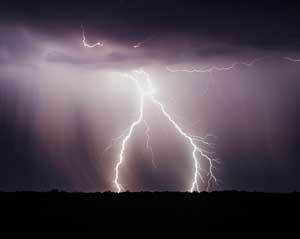
Lightning is another potential source of incredible power. One lightning bolt contains over 5 billion Joules of energy, enough to power a complete household for a month.
Many failed attempts and theories to catch and use this power, has highlighted the difficulties in trying to capture that much power. And we don't even know when or where it will strike, or how to capture it to start with.
As difficult as it is for scientists to figure out a way to capture and harness this incredible power, the solution is just one breakthrough away.
So what is the point of highlighting all these renewable energy sources? The answer is that the weather alone provides more than enough power to satisfy current and future global energy demands.
The biggest single factor that is holding us back is the lack of storage capacity. All this power is useless if we don't develop battery capacity to the point where it and can store large amounts of power for extended periods of time.
We probably would have been at the point of completely eliminating the problem by now if the research wasn't held back and slowed down for decades. Simply because of politics, red tape, and economic manipulation to keep oil and coal at the forefront of energy production by governments and large international energy corporations for decades.
But you know the saying, "Necessity is the mother of all invention." Well, since it became clear that fossil fuels are finite, and so is our planet's ecosystem, we reached a tipping point.
A little more than a decade ago, the Toyota Prius really started the electric car revolution and was released worldwide. It was a combination of electric and internal combustion power. The second-generation all-electric Prius, released less than a decade ago, had an electric range of 25 miles (40 km).
Compare this with the latest Tesla Model S, which has taken battery capacity to a whole new level and has an all-electric range of 335 miles (539 km)! More than twice that of the Prius in less than a decade. Imagine where we will be in another decade.
The point is that nature has more than enough energy, and human ingenuity & know-how has the ability to harness and store this energy to be used in anything from a power station to a cargo ship traveling for thousands of miles across the world's oceans.
It really is just a matter of time...
51) Cloud Seeding And Other Attempts To Make It Rain
Attempts to artificially create rain dates back to the 1940s. The first attempts were made through a process called cloud seeding. In 1946, Dr. Bernard Vonnegut discovered that supercooled water droplets would turn into ice when it came into contact with silver iodide.
Cloud seeding is the release of silver iodide by an aircraft into the atmosphere above a cloud, saturated with an adequate amount of moisture. The theory is that the silver iodide will collide with the supercooled water droplets, turning them into ice, which will then fall to the ground while melting into raindrops.
Obviously, this method caused a lot of controversies and is still criticized by fellow meteorologists and even ridiculed in some circles. Although the jury is still out on its effectiveness, there is growing evidence that this method is actually effective under the right circumstances and can increase rainfall by 10-15%.
Quite a few more methods and theories are constantly being developed to try and modify weather events. This includes China's arsenal of 5000 rocket launchers, which is fired into the clouds, releasing particles in an attempt to make it rain.
Abu Dhabi is using umbrella-shaped towers to send negatively charged particles into the sky to create rainfall. I will spare you the details, but let's just say that most meteorological experts are skeptical at best.
52) The Effect Of Weather On Your Mood
We all know the stereotypes and associations: Being down and depressed (having the winter blues), having a sunny disposition (normally associated with summer and the sunny weather making people feel more positive and happy) etc.

I honestly thought I was the only exception to the rule. Warm and sunny weather always makes it difficult for me to concentrate and makes me feel irritated very quickly.
I also hate getting hot and sticky, and exposure to direct sunlight always gives me a headache and have a negative effect on my tolerance levels. Not to mention the feeling of being constantly tired and lethargic. Some research needed to be done...
So, what do the experts say? As it turns out, the weather does indeed affect our moods, but not in the way you might think.
In 2008, a group of German researchers conducted a study on 1233 people. Apart from the expected physical effect of getting tired and exhausted by exposure to sunlight, they couldn't establish any general relationship between weather and mood, due to each subject's own sensitivity to weather.
Theo Klimstra examined this further, and after conducting a study in 2011, he concluded that people could be divided roughly into four distinct groups as their moods relate to the weather:
- Unaffected People (no associations between weather and mood)
- Summer Lovers (a better mood with sunny and warm weather)
- Summer Haters (a worse mood with sunny and warm weather)
- Rain Haters (a bad mood during rainy weather)
This study reinforced an earlier study done by Mathew Keller, who also couldn't find any specific correlation between weather and mood on a broad spectrum of individuals.
So, the weather definitely affects the way we feel. What type of weather triggers what type of mood might be entirely up to you personally, though.
53) Man-Made Attempts To Affect The Weather
In a previous point, we already discussed how cloud seeding is used to artificially trigger rainfall in a cloud saturated with moisture, with varying amounts of success.
Rain is not the only form of weather that we are trying to effect, though. Unlike rain, some weather events are trying to be prevented and not promoted. And with good reason.
Hail storms cause millions of dollars of damage to crops, vineyards, and plantations worldwide each year. It is entirely understandable that serious attempts are being made to limit or even prevent it.
The hail cannon is one of the most well-known and popular inventions used to try and stop hail from occurring. An explosion is set off in the lower chamber of the cannon, sending a large boom into the sky. The process is repeated every few seconds as stormclouds start to move in.
The reasoning behind this method is that the shockwave caused by the explosion will break hailstones apart before it reaches the ground. There is, however, very little scientific evidence that this method actually works and is mostly met by criticism from the scientific community.
Another weather event man is trying to control lightning, which is as dangerous as it is spectacular. Its power and unpredictable nature are just a few of many reasons attempts are being made to manipulate it.
One approach is to attach one end of a wire to the ground, with the other end attached to a rocket that is fired into the storm cloud. The thinking behind this idea is to lead the lightning down the wire to control the path of the lightning strike.
Not knowing when or where a lightning bolt will form makes this approach a rather futile endeavor. Recent experiments using a high-intensity laser beam to redirect lightning, conducted by the University of Arizona, is showing more promise.
54) Tornadoes On Mars?
Yes, you read that right. And the answer is also yes, well sort of—time to explain.
The fact that NASA has been landing probes on Mars since the end of the last century, combined with an increasing amount of satellites (rotating the red planet and studying its surface), allowed us to learn a lot more about our neighbor.
One of the surprising phenomena we probably didn't expect to find was the millions of tornado-like whirlwinds occurring across the planet.

Actually, they are not technically tornadoes but dust devils, a much smaller (and mostly harmless) whirlwind that is also found back here on earth. It is caused by swirling updrafts in sunny conditions.
On Mars, there are literally millions of these dust devils (around 13 meters in diameter and reaching up to a kilometer in height) present on the surface at any given time, formed in low-pressure systems.
This means that wherever you find yourself on the planet's surface, you will be able to see dozens of these small whirlwinds that hang around for a few minutes before disappearing.
I know we already touched on weather events on other planets in an earlier section, but this is such a unique phenomenon that occurs on such a large scale on Mars that it really deserves its own section.
55) Why The Sky Is Blue (Seriously...)
This is something we have all been very well aware of throughout most of our lives. When you look at the sky on a sunny, cloudless day, it appears blue. As simple as that. The only reason you may look twice and be taken by surprise is looking up, and the sky has turned into some other color besides blue.
But how many of you really know why the sky is blue? After all, the light generated by the sun is actually white. But as some of you who had ever seen the light shown through a prism will know, white light actually consists of many colors - all the colors of the rainbow, to be precise.
Each of these colors travels at different wavelengths. As light from the sun hits the earth's atmosphere, these colors get scattered by particles and gases in the air. Blue light gets scattered around much more than any of the other colors, making them highly visible.
As a result, it's the scattered blue light that gives the sky its blue color. It is not a case of the other colors not reaching the atmosphere at all. They simply don't get scattered as much as blue light, and as a result, are not as visible.
56) It Is Literally Raining Fish And Frogs
If you ever heard stories of frozen frogs or fish raining from the sky, you can be forgiven for being a bit skeptical. It is actually a very real but rare phenomenon that happens all over the world. There is also a very logical and straightforward explanation for these occurrences.
The most accepted and logical theory is that it is the direct result of tornadoes. Tornadoes (in the form of waterspouts) travel over water. The strong suction power of the surface winds picks up the surface water and living creatures in it.
Supercells, the cloud system in which tornadoes occur, have a very high vertical buildup. They can easily reach heights of 12 km (40 000 feet). As a result, they can carry aquatic life like frogs and fish high up into the upper atmosphere and drop them several miles away to fall to the ground "from seemingly nowhere."
It is no surprise then that occurrences of frogs falling to the ground in various states (from alive and bewildered to completely frozen) have been reported.
57) Meteotsunami (Or Meteorological Tsunami)
A Meteotsunami also called a meteorological tsunami, it is very often mistaken for a "normal" tsunami that is caused by seismic activity (like earthquakes or the shifting of tectonic plates).
Unlike a typical tsunami, a meteotsunami is the result of a sudden change in atmospheric conditions, specifically air pressure. A sudden disturbance in air pressure, often caused by fast-moving weather systems like squall lines, triggers the wave movement.
If the wave is formed in relatively deep waters, it travels in exactly the same way as a regular tsunami, carrying a lot of momentum with it, which allows the wave to build up in height as it enters shallow waters.
The same catastrophic results also follow when it makes landfall, flooding the shoreline with large volumes of devastating water.
This means it doesn't matter whether an earthquake or low-pressure system causes the wave and the resulting devastation. It simply means that a weather event can be just as an important impetus as any seismic activity in the formation of a tsunami.
58) Frost Flowers in the Arctic
Unfortunately, most of us will never be fortunate enough to see them, simply because of the environment required for them to flourish in. Frost flowers are as beautiful as they are elusive to most of us.
There are different types of frost flowers, but the ones I am referring to in this section are the meadows of frost flowers that are found in the Arctic Regions, which provide the perfect environment for the forming of these ice structures in their purest form.
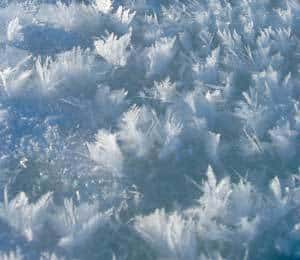
Frost flowers are ice crystals that grow on newly formed sea ice. Without going into too much detail and making things too complicated, we still need to have a proper idea of how they are formed and develop.
Under calm conditions, a new ice layer is easily formed as the air over the open water is much colder than the underlying ice. The air directly above this newly formed ice contains high levels of water vapor and is also much warmer than the overlying layer of cold air.
If this difference in temperature between the moist warm air on the ice surface and the colder overlying air is 15 degrees or more, condensation will take place where the two layers meet.
The condensation will cause small ice crystals to form kernels on imperfections on the ice surface. If the conditions stay calm, more moisture will be deposited on the small kernels, allowing the frost flowers to grow.
In the right conditions, meadows of these frost flowers are formed, which is a very rare and beautiful sight. Most of us can only admire them in photos, but it's still nice to know there are so many extraordinary weather creations out there most us yet don't know about.
59) "Fog Tsunamis" - Nature's Sense Of Humour
Over the years, beachgoers and novice sailors across the world had the living daylights scared out of them by the freighting sight of a 10-story-high tsunami racing towards them. Imagine both the relief and feelings of sheepishness when they realized the "tsunami" was, in fact, nothing more than one of nature's clever illusions.
What they were seeing was actually a thick bank of fog that is formed when the weather conditions are ideal. Especially when these thick fog banks are running parallel to the shoreline, they can appear almost indistinguishable from the ocean, creating an intimidating sight for anyone "in its path."
When warm moist air blows over the cold ocean waters, condensation takes place, and fog is formed on the ocean's surface. If enough moisture is present and the resulting condensation continues to occur, it can build up an impressive bank of fog, often referred to as "fog tsunamis" due to their appearance.
They are completely harmless, and the only real danger they cause is limiting visibility to only a few meters in some cases. When these "fog tsunamis" coincide with onshore winds, the fog can be blown some distance inland and further limit visibility.
60) Asperitas Clouds - More Bark Than Bite
When you happen to look out your window one morning and see these alien-like dark clouds with round wavy bellies, relax. You didn't wake up on another planet, and earth is not about to be invaded.

In fact, Asperitas clouds are not even potentially dangerous storm clouds and often disappear without a single drop of rain falling. It is a very rare type of cloud and has mostly been spotted in The Great Planes in the United States, characterized by its wavy shape and round bellies underneath the cloud.
There is still much uncertainty as to how these clouds formations are formed, and no clear pattern has been established yet. (Asperitas clouds are a relatively recent discovery and the latest member of recognized cloud formations, acknowledged by the World Meteorological Organisation in 2015 at its 17th Congress.)
One thing all meteorologists agree on is that the atmosphere needs to be unstable for the unique wavy shape to form underneath the clouds.
As long as there are so many different theories and uncertainties surrounding the formation of Asperitas clouds, there is no point in wasting your time by discussing them all.
It is yet another example of a weather event that both puzzle and amaze us. If you get the rare opportunity to experience one, grab your camera or phone and start taking pictures.
61) Hailstones CAN Be Fatal And Kill You
In general, hail storms produce hailstones a few millimeters thick, not even big enough to cause any significant damage. Most of us see it more as a novelty and enjoy lawns and roads being covered with a layer of these icy white balls.
There are certain instances, however, where hailstones are much larger. So large, in fact, that significant damage is done to infrastructure, cars, and vegetation. And in some cases, even cause fatalities.
There are dozens of documented cases where multiple fatalities occurred, and hailstones the size of oranges were recorded. One of the worse cases, however, took place in Moradabad, Northern India, on 30 April 1888. At least 230 people were killed, and over 1600 of livestock perished. Unfortunately, no warning system existed at the time.
The important take-away here is never to underestimate a hailstorm and rather be safe and take cover underneath a structure with a solid covering.
62) The Hidden Dangers Of Black Ice
Motorists used to driving in icy conditions during winter times are probably already aware of this phenomenon, but to anyone unfamiliar with back ice, it can be quite dangerous and catch you off-guard.
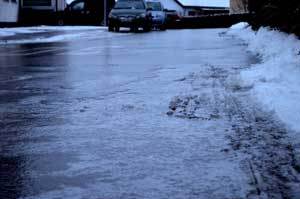
Black ice (also referred to as clear ice) is a very thin layer of transparent ice deposited on surfaces, especially road services. It makes the surface extremely slippery, and because it is transparent, motorists driving over this surface can easily be caught off-guard and lose complete control over their vehicle.
The extremely slippery surface makes vehicle wheels lose traction with the road, causing them so slide in any direction, often colliding with other vehicles or objects along the roadside. It can happen, even if you are already driving cautiously and at a slow speed.
Black ice forms when a slight drizzle falls on a surface that is already below freezing point (0° Celsius or 32° Fahrenheit), and it immediately turns into solid ice. The moisture from vehicles' exhausts can compound this effect, which also turns into ice. Because the layer of ice is so thin, remains almost completely transparent.
Even cyclists and pedestrians can fall prey to back ice, as it can be a treacherous surface for anyone crossing it.
63) Can Thunderstorms Damage Airplanes?
The short answer is potentially yes, but luckily very rarely and mostly with little effect.
In general, it is quite safe to fly in stormy weather. The first reason is that modern aircraft are designed according to strict specifications to handle extreme weather conditions. They are strengthened in the right areas and build to insulate passengers from the elements.
Wind shear, hailstones, and icing may cause some degree of damage if an aircraft is forced to fly through a thunderstorm (normally a high cumulonimbus cloud), but is normally too little to cause any concern.
A direct lightning strike travels through the outside metal surface of the aircraft and exit it with maybe some minor entry and exit burns at the most, but leaving passengers well insulated and leaving the aircraft unaffected.
The second reason why it is safe, it that modern aircraft travel at a height of around 30 000 feet (10 km). This not only because the air is thinner at such a height and fuel is saved, but also because most weather events take place below this height, essentially allowing the aircraft to fly above the weather.
Obviously, there is the rare occasion where cumulonimbus clouds reach high into the upper atmosphere, or severe weather conditions cause significant damage to an aircraft when forced to fly through it. This happens very seldom, though, and in most cases, planes will still survive the storm and make a safe landing.
64) Can Hurricane Sized Waves Sink A Large Ship?
During strong hurricanes, the high wind speeds can generate incredibility large waves with heights of up to 60 feet (18 meters) or more. This can be dangerous, even for the largest and heaviest of ships like oil tankers and cargo ships.
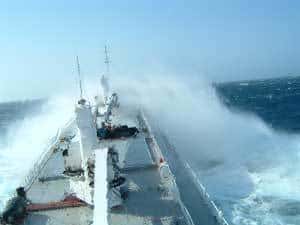
The continuous pounding by these heavy waves has the potential of causing structural damage and eventually break a ship apart. History has shown that large ships can and were indeed sunk by hurricane-strength waves.
Ironically enough, most harbors are the last place you want a large ship to be when a hurricane approaches. The ship will be repeatedly thrashed against the concrete docks, causing damage to both. Chances are the mooring lines may snap, turning the ship into a floating wrecking ball in the harbor.
When a hurricane is detected early enough, ships are often ordered to leave the harbor and sail out of the direct path of a storm.
In the worst-case scenario, a ship cannot get out of the way in time and need to face the storm directly. It needs to make sure it follows two important rules:
- Sea Room: It must be far enough away from other objects, including the coast, not to be blown into them or get stranded.
- Steering-way: It must have enough power to steer and move forward and not being pushed around by the waves. The bow (front) of the ship must always be pointing into the waves, as large waves hitting it from the side can actually cause a large ship to tip over and sink
Sometimes, an experienced crew and well-maintained ship are the most important factors that will determine a ship's survival in these horrific conditions.
65) Impact Of The Weather On A Country's Economy
When you think of seasonal changes in weather patterns, the agricultural sector is one of the first things that comes to mind, and with good reason. A healthy agricultural sector always contributes to a country's strong economy.
An abnormally long dry season can result in a complete loss of crops, while the drought will have an adverse effect on livestock. Similarly, a very wet season with extensive flooding will have an opposite effect, but with the same results.
This will not only severely inhibit a country's ability to feed its citizens, but also put further strain on the economy. The loss of income, normally received from the surplus of the produce used to be exported to foreign countries, puts additional pressure on the economy.
In fact, due to the shortage of produce normally grown and processed locally, many of it will now have to be imported at an additional cost.
National disasters like hurricanes and flooding due to abnormally high rainfall can also cause widespread damage to buildings, roads, and infrastructure in general. The cost of repairing the infrastructure of a region can run into billions of dollars.
(And this is not even taking into consideration the cost of the loss in productivity during this period.)
It should be very obvious by now that the weather does indeed have a very big influence on any country's economy.
66) How Temperature & Rainfall Affects The Weathering Of Rocks
We think of rocks as hard, solid, and durable objects that are mostly unaffected by the usual wear-and-tear which most other objects, natural or man-made, are subjected to.
It may come as a surprise at how prone many rocks are to weathering (the process through which rocks are broken down into smaller pieces and eventually wither away).
Weather, especially heat and rain, is one of the main factors contributing to the weathering process. As not all rocks are created equally, some take much longer to weather and respond differently to the type of element it is exposed to.

We still use rock in modern times for a variety of purposes. From the inclusion in concrete mixes for all kinds of building projects to the construction of road surfaces. It is even still being used as the primary building blocks for houses, walls, and roads in some countries.
It is, therefore, quite essential to understand how different rock types respond to the weather.
For example, in wet climates, rock is broken down much more quickly than in dry climates. Carbon-dioxide in soil mixes with air and water and forms a weak acid, which breaks down much more rapidly. Rocks like limestone are especially vulnerable to this type of wear.
Some rocks like sandstone react entirely differently, though. With quarts in it being more resilient to chemical breakdown, they are not so much affected by wet rainy weather.
In contrast, they break down much more rapidly in cold, dry conditions. The small cracks in the rock allow cold water in these cracks to freeze and expand. This leads to a fracturing of the rock into smaller pieces.
These are a few small examples of a much bigger topic, but it is interesting to note how weather even interacts with geology.
67) The Benefits Of Living In A Dry Climate
Places normally associated with a dry climate like deserts and semi-arid regions are normally seen as inhospitable with extremely high temperatures, making it an "extremely poor choice" when deciding on a place to call home.
First of all, not all deserts and areas with dry climates are warm. Some deserts actually have quite moderate temperatures, while others at higher altitudes are quite cold.
Secondly, vegetation may be a lot scarcer and different from that of regions with a humid climate, but dry regions have a different type of vegetation that has adapted to the arid conditions and have a unique beauty of their own.
Then there are the numerous benefits. In the previous section, I already touched on the fact that rain and humidity accelerate the breakdown of rock. But it's not just the deterioration of rocks. Humidity causes the accelerated breakdown of almost any material you can think of, whether man-made or natural.
It is no secret that motor vehicles in coastal regions are much more prone to rust compared to the vehicles in drier inland regions. (This is reflected in the resell value of vehicles, where adverts in classifieds will highlight the fact that a vehicle originated from a "non-coastal" region.)
It is also no secret that humidity is no friend of electronics. The oxidation of some components and other forms of deterioration affects their reliability and shorten the life of many electronic devices. (With most appliances now having some form of electronic component, this is not good news for people in humid areas like the tropics or the coast.)
Lastly, there are the many health benefits that are too numerous to delve into. It includes the reduction and reduced risk of diseases like arthritis, asthma, and heart disease.
(The health benefits of increased exposure to sun include reduced stress, lower blood pressure and a multitude of benefits triggered by the production of vitamin D as a result of exposure to the sun.)
And off-course, you get the added benefit of the unique beauty of these open landscapes accompanied by breathtaking sunsets.
68. Does The Moon Affect The Weather?
Many of us already know that the moon has an effect on our oceans, specifically our tides, and even more so when a full moon is present. Interestingly, it has some effect on the weather as well, but not nearly as much as on the ocean's tides.
The moon's gravity directly affects the part of the ocean closest to it by causing a slight "bulge" on the oceans' surface (as that part of the ocean is pulled up by the gravity of the moon.) This "bulge" then follows the movement of the moon, and this is how tides in the ocean are formed.
The moon's gravity also has and effect on the atmosphere above the ocean. As air contains weight, it is also subjected to the gravitational forces of the moon.
Because air and the gases in it, is so light and much less dense than water, the influence of the gravitational forces on the atmosphere is almost non-existent compared to the effect on water. As a result, it is completely dwarfed by many other factors.
The moon also has a very small but notable effect on temperatures at the Poles. During a Full Moon, the temperatures at the Poles are 0.55° Celsius (0.99° Fahrenheit) warmer than during a New Moon.
So yes, the moon does have some effect on the weather directly. Don't expect it to become front-page news on any newspaper or website anytime soon, though.
Important Weather Tips
69) What To Do When Caught Outside During A Lightning Storm
If you are caught outside, and a thunderstorm hits, get inside as quickly as possible. If you happen to be too far away from any form of shelter, find the lowest-lying area you possibly can, like a ditch or bottom of a valley
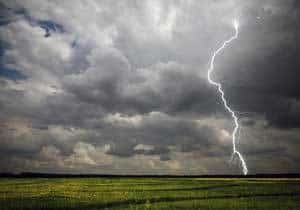
Stay away from any tall objects (that are prone to be hit and conduct lightning) and water (like dams and rivers).
Lastly, make yourself as small and low as possible by crouching down (like a baseball catcher's position or wicket-keeper in cricket), with only your heels touching the ground and your head between your knees.
Following these steps will significantly reduce your chances of getting hit by a lightning strike.
70) What To Do When A Tornado Strikes
Get Underground: The best place to stay safe is to hide in an underground shelter or the basement of your home.
If you don't have an underground shelter, find the innermost room of your home, preferably also the lowest. The more obstacles, in the form of walls, you put between you and the tornado, the better.
If you are stuck outside, finding a low-lying area like a ditch might be your best option. Lay down and cover your head.
Stay Away From Windows And Outer Walls: The strength of the wind, even when a tornado is not directly hitting you, is more than strong enough to shatter glass, turning them into dangerous sharp projectiles which can seriously injure you.
Outer walls are unlikely to withstand the strength of a tornado, and instead of providing safety, will most likely be blown over or collapse on you, which can lead to serious injury or even cause fatalities.
When You Are On The Road: If possible, find the safety of a shelter as quickly as possible (the type already mentioned). If you are unable to do so in time or get out of the way of the storm quickly enough, get out of your car and find a ditch as far away from your car as possible. (The tornado may toss the car and blow it onto you.)
71) How To Protect Your House From Lightning
Lightning causes billions of dollars worth of property damage across the globe each year. Even more importantly, it can cause serious injury and even fatalities, either through direct electrification or as a result of fires that are started due to power surges.
The following four steps can be taken to significantly reduce the risk of damage and injury when lightning strikes:
- Using a home lightning protection system: Using a combination of lightning rods, surge protectors, grounding devices, main conductors, and bonds will help to insulate and protect you and your household appliances and equipment.
- Unplug all electronic devices: When a thunderstorm is imminent, make sure all electronic devices and appliances that use electronic circuitry are unplugged.
- Installing transient voltage surge protectors: For devices that are plugged in when you are not home when lightning strikes, or devices that are critical to keep running at all times.
- Always check your insurance coverage: If you live in an area prone to lightning strikes, make sure you know exactly what you are covered for, and make the necessary adjustments and alterations.
Although you cannot completely protect yourself from lightning strikes, implementing these four guidelines will go a far way to protect your home.
72) What Not To Do When A Tornado Strikes
Hide Underneath An Overpass When On The Road: This is a popular misconception that is still propagated and followed by many people. The last thing you should do if there is no alternative is to leave the relative safety of your car to shelter underneath an overpass.

Not only are you completely exposed underneath the overpass and more likely to be hit by dangerous flying debris, but the shape of an overpass causes the winds in a tornado to funnel underneath an overpass, strengthening it and causing much more turbulence as a result.
As already mentioned, if you can't find a solid structure to shelter in, rather find a ditch as far away from your car as possible to hide in, lie down, and cover your head. If none of these options are available, staying in your car and trying to ride it out is your safest bet.
Do Not leave The Safety Of Your House And To Try And Outrun A Tornado: If you are already in your house, stay there! Even if you don't have an underground shelter, the innermost room of your house is still far safer than being exposed out on the open road.
You don't know which direction the tornado will go in or that you will be able to outpace it with your car. Getting stuck in traffic jam or hindered by fallen debris is also a big probability, leaving you exposed and in serious danger.
73) What To Do During A Thunderstorm
Lightning can strike, even up to 16 km (10 miles) from the center of a thunderstorm, so care should be taken, even if it sounds relatively far away. As a rule of thumb, you can count to 30 between seeing the lightning and hearing the thunder. If the time is less than 30 seconds, you are not out of danger.
If you are inside your home or car when a thunderstorm hits, stay there and keep all windows and doors closed. If you are caught outside, stay away from and tall objects or trees, which are very prone to be hit by and conduct lighting.
Even when you are inside your home, avoid direct contact with water, electronic devices, telephones (landline), and even concrete walls. Lightning can travel through plumbing, electrical wiring, and even though the steel reinforcement inside concrete walls.
74) How To Predict The Weather Using Nature
Nature is much more sensitive to coming changes in weather than we might realize. It can often "sense" weather events hours, or even up to a day before we become aware of it. By paying attention to the little clues nature gives us, we will be able also to become aware of weather changes without even looking at a weather forecast.
For example, an increase in humidity very often precedes rainy weather. Nature reacts to it in a variety of ways. Pine cones close up, the leaves of maple trees start curling and, even the smell of flowers are much stronger than usual.
Insects and animals also leave many clues. Many of us are already familiar with the ant invasions into our homes preceding rainy weather, sometimes days in advance.
If you live in an area reach in birdlife, a sudden quieting down in bird activity is often an indicator of stormy weather on the way as they take shelter.
There is a lot more to this subject, which I just briefly touched on. If you would like to know more, a whole article is dedicated to the hints and clues that will help you "forecast" your weather. You can read the article by following this link.
75) What To Do In A Heat Wave
The obvious and most important thing you can do is to stay hydrated. Whether you find yourself indoors or outside, always keep water with you, which you should drink regularly, even if you don't feel particularly thirsty. (Your body is dehydrating much quicker than you might realize.)

As heat always rises, staying as close to the ground is always advisable. In extreme conditions, heading downstairs into a cool basement may be necessary.
When outside, try and avoid direct sunlight by staying in the shade and wearing cool protective clothing, especially the appropriate headgear.
Try and avoid additional sources of dehydration. This includes avoiding beverages like alcohol and caffeine (which leads to further dehydration) and taking off unnecessary warm clothing.
Apart from drinking, water can be used to keep you cool by taking a cool shower or bath, wiping yourself down with a wet towel, or even sitting with your feet and lower legs in a bucket or tub.
You can find more useful information about heatwaves in this article.
76) How To Survive Extreme Cold Weather Conditions
Those of us living in countries with more moderate climates will seldom, if ever, experience these extreme cold weather conditions. For many people living in countries close to the arctic circle, though, this is very much a stark reality, especially during winter times.
For countries like Canada, Russia, and many Scandinavian countries, this is just part of everyday life during winter seasons. Occasionally though, even they experience exceptional cold conditions that need special care.
Also, with Climate Change causing increased temperature fluctuations around the world, more countries previously not affected are experiencing these extremely cold conditions regularly. This means many people may now have to adjust to conditions they have not experienced before.
The first and most obvious thing to do is to keep your body warm by wearing warm clothes, specifically the type especially made for wearing in very cold conditions. It is also much easier and uses a lot less energy to stay warm in the first place than to try and warm your body up after getting too cold.
Stay indoors. If there is no real necessity to go out outside, don't risk it. Many people underestimate how quickly extreme weather can set in and affect your body.
Always stock up on sources of heat. This includes fuels to stay warm, especially in areas where severe weather may cause power outages. This includes traditional sources like gas and wood (many northern countries still rely on fireplaces to stay warm).
Make sure your home is properly insulated from the cold. If you live in an area often affected by extreme cold, make sure your home is properly sealed and use insulation materials to help keep the heat in and cold out.
Wear your clothing in loose layers. By wearing tight clothing, you are restricting blood-flow and inhibit the body's ability to stay warm. Layered clothing also allows pockets of warm air to be trapped in between these layers. This acts as an extra layer of insulation against the cold.
Be aware of the dangers and symptoms of hypothermia and frostbite. If you were directly exposed to extreme cold for an extended period of time, you might not even be aware that you are suffering from any of these conditions. Inform yourself about these conditions and follow the advice from people experienced with extreme cold and what to be aware of.
Avoid Sweating And Stay Dry. Dressing too warmly or heating a room too much can cause you to perspire, which is never a good idea. Moisture on your skin will inevitably turn cold when you are away from a source of heat, which can severely impact your body's temperature.
These are just a few examples. There is a lot more you can do, so make sure you are properly informed and educated when you are heading to a location you know will experience these extreme cold conditions.
77) Using Clouds To Tell Future Weather Events
Although clouds are normally observed and associated with the weather conditions we are experiencing at the time, they have a lot more to offer. Keeping an eye on clouds some distance away can also give you a pretty good indication of future weather events.
You can actually tell a lot by paying attention to a cloud's color, shape, and height. This will help you to make a rough "forecast" about what the weather will do in the coming hours.

Clouds are made up of thousands or millions of microdroplets. The more moisture a cloud contains, the darker the color. It should come as no surprise, then, that the clouds we normally associate with stormy, rainy weather are usually very dark in color.
The much lighter, almost feathery like clouds, on the other hand, normally contains very little moisture and are normally an indication of clear and pleasant weather conditions.
The actual height of clouds also tells us something about the coming weather events. Clouds with their bases high in the air (cirrus, cirrocumulus, and cirrostratus) are generally not associated with rain, whereas low-lying clouds are more commonly associated with rainfall.
Finally, the shape of clouds is yet another potential indicator of future weather conditions. Clouds like cumulonimbus have a very low base, but also a huge vertical buildup. Huge vertical development in cloud formations is often associated with stormy weather.
The thin and streaky appearance of clouds with very little vertical development (like cirrus and cirrostratus clouds) more often than not points to pleasant weather conditions.
78) Steps To Take Against Monsoon Dangers
Visitors to India will be exposed to a wealth of sites and sounds of this colorful and diverse nation. Extreme care should be taken, though, when visiting during the Monsoon Season. (You can find out more about what monsoon is what the dangers are in this article.)
During A Monsoon: The amount of heavy rain that can fall in a short period of time very often leads to flash flooding. Stay away from low-lying areas, especially areas near streams, rivers, and dams.
Even structures in these areas can become unstable due to the force of the water. Avoid these structures, as they may not withstand the amount of water and collapse on you.
The hillsides and mountainous areas can become very prone to mudslides and rockfalls during heavy rains. Keep your distance from these mountainous areas and avoid roads winding through hillsides during and directly after a monsoon.
After A Monsoon: The most dangerous part of a monsoon though, is not the rain or flash flooding, but the waterborne diseases that form in standing water, which can stay in certain areas for days or weeks following a flash flood.
Many of these diseases can be fatal if not treated quickly. Taking the appropriate vaccination against diseases like Typhoid and Cholera is very important, as well as taking subscribed malaria pills before your visit.
Not all these treatments are 100% foolproof, and some waterborne diseases like Viral Fever and Dengue have no preventative medication. The best way to limit exposure to these diseases is by taking a few safety precautions following a monsoon:
- Avoid bathing in or coming in direct contact with contaminated water (e.g. streams and dams)
- Avoid contact with infected bodily secretions.
- Don't Eat Potentially Contaminated Food (e.g. food from the street and open-air markets)
- Protect yourself against insect bites, especially mosquitoes (use insect repellent & mosquito nets)
- Avoid drinking contaminated water
These are just a few general guidelines to use, but follow your general practitioner's advice and immediately pay attention to and report any symptoms of the disease.
79) Do Not Be Fooled By A Hurricane's Downgraded Strength
With modern weather technology, meteorologists are able to identify and track hurricanes while it still over the ocean, quite a few days before it makes landfall.
During this period, strong hurricanes often get downgraded to a lower-strength category, creating a false impression among people in the path of the storm that the danger is lessening or disappearing. The result is that many people get caught in a hurricane with potentially deadly results, which they could have avoided by getting out of the way in time.

The strength of a hurricane is mostly an indication of the wind speeds present in the eye-wall with Category 5 being the strongest (157 mph or stronger wind speeds) and Category 1 being the weakest (74-95 mph wind speeds).
Although wind speed is a significant indicator of the strength of a hurricane, you should always remember that it is the rainfall and resulting flooding that is by far the most significant danger that a hurricane poses.
And it is the size, the speed at which the actual hurricane is traveling, and the amount of moisture it carries that determine the rainfall and flooding. (Not the wind speeds within the hurricane itself.)
Never look at the downgrade of a hurricane's strength to determine its potential danger. Heed all official warnings and get out of its path when told to.
80) What To Do When Weather Changes While On A Boat
If you own or operate a boat, at some point, you will encounter bad weather. Whether on a lake or the ocean, if you are not a seasoned sailor, you will need to learn how to deal with bad weather and rough waters. (Preferably sooner rather than later).
As I am not going to try and pretend I know anything about boating or anything remotely related to it. Having said that, I feel this post will not be complete if I don't at least do the proper research and provide you with the best information I can find.
I found the following guidelines to be the best summary of actions to follow when confronted with bad weather while operating a boat. This guide also corresponds exactly with one supported by Transport Canada, so it is well worth paying attention to.
When encountering stormy weather while on water:
- Slow your craft down, but maintain enough power to keep your heading and course.
- Store away loose and unused gear.
- Close all openings (windows, hatches, doors) to prevent flooding of the craft.
- Keep your boat's bilges free of water. Also, be prepared to scoop/pump water entering bilges out if necessary.
- Keep visibility at an optimum by using navigation lights and your radar (if you are in possession of one), while signaling your position using a foghorn.
- When lightning is present, stay away from all metal objects and disconnect all electronic equipment.
Please know that these few guidelines are just scraping the surface of sailing in bad weather. If you are going to operate a boat, make sure you are fully qualified to do so and are fully informed and prepared before you venture out into open waters.
Home Weather Station Tips And Information
81) Always Consider Height When Placing Your Home Indoor Weather Station
The air in your home reacts very much in the same way as the air outside in the earth's atmosphere. This means the colder (and heavier) air is located closest to the floor, while the warmest (and lightest) air is located at the ceiling or the highest point in the room.
(This is why your attic is always the hottest location in your house and the cellar the coldest.)
The best possible height to place your weather station is about halfway between the floor and ceiling. Luckily and conveniently, this is normally more or less at eye level when seated, which makes it a very practical location.
82) Choose Your Room Where Your Indoor Weather Console Will Be Placed Very Carefully
There are certain rooms that are completely off-limits when it comes to indoor weather station placements. Time to expose the biggest culprits:
The Bathroom: Something you will find in every bathroom is a shower or bath (or both). Even taking a lukewarm shower will cause a dramatic increase in humidity and temperature. Even using the washing basin or flushing the toilet has a bigger effect on humidity than you think.
So you can imagine the dramatic effect it will have on a weather station's readings. This room is a very big no-no.

The Kitchen: Like the bathroom, the kitchen is also a source of artificial influences on the air, especially the air temperature. Your stove, microwave, and even your fridge generate a significant amount of heat.
Heated food from the stove and microwave also generate enough steam to significantly change the humidity. These factors make the kitchen just as unsuitable for weather station placement.
Rooms Receiving Direct Sunlight: Many houses are built in such a way to make the most use of sunlight. (In the Northern Hemisphere, you will find many rooms facing south to receive more sunlight, and in the Southern Hemisphere, many rooms are facing north for the same reason).
Although this helps to keep these specific rooms warm during winter times, it creates a much higher temperature than that of the outside air or the rest of the house. Preferably, these rooms should be avoided. At the very least, place the weather station as far away from the window as possible and out of direct sunlight.
83) Always Place Your Outside Sensor Array High Enough From The Ground Surface
A very important factor for determining the accuracy of your outdoor sensors array's readings is your unit's actual physical height above the ground.
The first reason for this is to get an accurate humidity reading. Especially when placed in the back garden or any area that contains plants, grass, or even bodies of water, the accuracy of the hygrometer may be severely influenced. The amount of humidity that plants and bodies of water add to the atmosphere must never be underestimated.
Another variable that can also be influenced by the surface below the sensors is the temperature. Whether the sensor unit is installed on the ground or on a roof, the surface of each still absorbs and reflects/radiates a lot of the heat from the sun back into the surrounding atmosphere.
As a result, when the sensors are placed too close to the surface below it, the accuracy of the thermometer will not be able to give an accurate reading. (The reflected/radiated heat from the surface below will add to the atmospheric temperature that is picked up by the thermometer.)
Luckily you don't have to get completely despondent here, as the solution to this problem is not that hard. You just need to ensure that your sensor array is approximately 6 feet above the surface below. This height is sufficient to make the influence of any surrounding objects and surfaces negligible.
84) The Amount Of Weather Sensors Do NOT Determine The Quality Of Your Home Weather Station
Many modern-day home weather stations come with so many weather sensors attached to their outdoor sensor array that it can actually be a bit overwhelming.
Is this a good thing? Well, I would say the answer is yes and no.
As already mentioned in other articles on this website, there are really three critical variables necessary to be measured and recorded:
- Temperature
- Humidity
- Air (Barometric) Pressure
These three measurements are used extensively by most advanced weather stations to establish weather patterns and calculate forecasts.
There are a few other variables, however, that play an important role in establishing and recording weather patterns. Recording weather elements like rainfall, wind speed, and direction helps you establish specific patterns and associate certain weather conditions with these patterns.
As important as all these sensors are, it is the accuracy and consistency with which your weather sensors are able to take measurements that matter the most. This is literally a case of quality over quantity.
85) Do NOT Rely Solely On Your Personal Weather Station's Forecasts For All Your Local Weather Information
Personal weather stations provide users with weather information specific to their location. They provide owners of large areas of land, like farmers and plantation owners, with invaluable rainfall and thermal readings to help them monitor & plan a variety of activities.
Using a home weather station in isolation, however, will be a very big mistake. Although it provides you with the most accurate and up-to-date data of your specific location's weather conditions, it can't match the capabilities of a professional weather service.
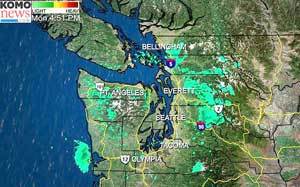
The first and biggest advantage of a professional weather service is its access to the vast array of weather sensors. From satellite & radar images, weather balloons to remote weather stations, they have access to detailed data of approaching & changing weather conditions up to thousands of miles away.
By tracking and analyzing this wealth of information, they are able to make very accurate forecasts of weather conditions in your location 5-7 days in advance. Variables that your home weather station's sensors will only be able to pick up a day before your weather conditions are affected.
86) Avoid Using The Default Settings When Installing An Advanced Home Weather Station
When it comes to advanced home weather stations, it is critical that you set up your device correctly. This means NOT leaving it in its default setting.
Most advanced weather stations actually need you to set it up correctly for your specific location to enable it to make the correct calculations, display the right information, and make accurate weather forecasts.
My Ambient Weather WS-2902A Osprey Weather Station for example, required me to set the correct date, time, and time zone. I also had to customize the barometric pressure to that of my specific location, and the setup even made me specify whether I am located in the Southern or Northern Hemisphere.
And unlike you might be thinking right now, it was actually a very easy and quick process with the easy-to-follow instruction guide. Most modern-day systems make it very easy for you to set up and customize your personal weather system.
Weather, especially air movement, reacts differently in the Southern and Northern Hemisphere. Barometric pressure also varies from one location to another. Setting the correct time zone also helps to calculate a variety of these parameters.
87) Never Blindly Follow The Claimed "Maximum Wireless Distance" Between Your Indoor Base Station & Outdoor Sensors.
It is really no secret that many manufacturers use the maximum distance able to be obtained between an indoor base station and the outdoor weather sensors as a selling point for their products. There is a very important fact they don't tell you straight away and is often added as an afterthought though.
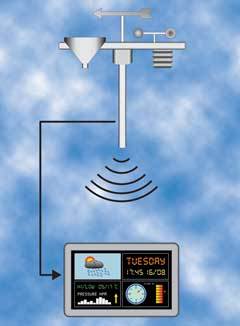
The maximum wireless range between the display console and outdoor sensor array (normally around 300 feet or 100 meters), is measured under the "ideal" circumstances.
This means the two devices have a direct line of sight with each, with no obstructions between them, and the measurements are taken under ideal weather conditions. Unfortunately, these ideal conditions very seldom exist in the real world.
More often than not, there are at least a few walls, roofs, or other obstructions between the two devices, which will limit the distance the signal can travel. The materials any obstruction consists of also have a large impact on the distance a signal can travel. (For example, a glass window will have very little effect on signal strength, while a metal construction will almost completely block a signal.)
88) Be Careful Where You Place Your Indoor Display Console
There are basically three main reasons for the importance of correctly placing your indoor weather station for optimal readings.
By having your indoor device closely resemble outside weather trends, you get a better and more complete picture of all weather conditions (both inside and outside), as well as a global overview of how these atmospheric conditions compare and interact with each other.
If you own a starter weather station, you may not even have the luxury of an outdoor weather sensor. In this case, it is absolutely critical to choose the right location, as the indoor weather station will rely solely on its own built-in sensor to take measurements and make forecasts.
When you have a weather station that displays both indoor and outdoor weather conditions, it is very impractical and very confusing to have two completely different trending weather conditions displayed right next to each other. (This can happen very easily in rooms like bathrooms or kitchens, where variables like humidity and temperature fluctuate often and extensively, creating very inaccurate measurements.)
I cover indoor weather placement (as well as the artificial sources that influence their ability to take accurate readings) extensively in this article. If you need more detailed information, feel free to go and have a look.
89) Place Your Sensor Array Far Enough Away From A Large Solid Structure
The whole point of placing your weather sensors outside is to expose it to all the weather elements without any form of interference. These elements include temperature, barometric pressure, humidity, wind speed & direction, as well as rainfall.
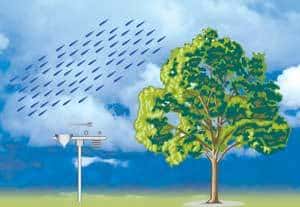
So if you place your sensors right against the sidewall of a building or underneath a big tree, what are you actually doing?
The first thing a wall will do is obstruct or completely block the movement of air. So there goes your anemometer's ability to measure wind speed and your wind vane's ability to accurately measure wind direction.
Depending on the location of the wall in relation to the sun, its surface will either be directly exposed to the sun or shielded from it for a large part of the day. This simply means there is no way for a thermometer affixed next to the wall to get an accurate temperature reading.
90) Don't Place Your Weather Station Close To A Body Of Water, Or Right In The Middle Of Some Lush Green Bushes
You need your sensor array's hygrometer to measure the humidity in the air without any type of outside (or artificial interference). Placing your sensor next to a body of water or in between lush green bushes is the worst possible thing you can do to achieve this.
Due to the amount of moisture evaporating from the water's surface and the moisture released by the leaves from plants & bushes, the humidity in the surrounding air is much higher than the actual humidity present in the air in your location.
You can learn all about your weather station's sensor array placement in this article.
Climate Facts
91) What Is Climate Change?

Climate change in itself is not an abnormal or dangerous occurrence. Over the last few million years, the earth went through numerous periods of Global Warming and Ice Ages. This happened over hundreds of thousands of years, though, giving all life on the planet to adapt and evolve.
The Climate Change everyone is debating over the last few decades is man-made and a vastly accelerated change in global and regional climate patterns, attributed mainly to the increase of carbon dioxide in the atmosphere produced by fossil fuels.
92) Yes, Climate Change Is Real
I don't make this statement lightly and are fully aware that the most experienced climatologist nor I will be able to tell what is going to happen next or how quickly it will happen.
One thing all scientists do agree on, however, is that this man-made accelerated climate change is very real. We already see clear evidence of this in the increase of extreme weather and geographical events on a yearly basis.
93) The Vital Role Of Climate In Soil Formation
The difference between cold, dry deserts (like the Gobi Desert in Tibet), and the lush green forests of Central America (like the Amazon Forest) would seem to be obvious. Apart from the difference in climate and vegetation, you might have missed another big difference: The composition of the soil.
And the composition of the soil is largely dependent on the climate of a region. Soil is able to develop much faster in hot and moist climates than in cold and dry climates.
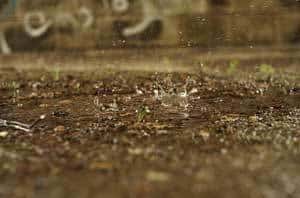
Rain is by far the biggest contributor to soil development. It allows dead organisms to decompose much faster and form part of the soil. Tree roots, bacteria, and animal burrows also "eat away" and cause the larger soil particles to break up into smaller ones.
The absence of rain in arid deserts is the biggest reason for the lack of dark, fertile soil that is so abundant in the wet rainforests.
In contrast, here, the rock is weathered down by heat and wind into the coarse sand that is so synonymous with deserts around the world.
This means a rainy climate is not just necessary for providing vegetation the moisture necessary to grow and survive, but also for the formation of fertile soil necessary for plants, trees, grass, and other flora to grow in.
94) Climate Affects Agriculture And The Fishing Industry
We can all be in agreement that every country depends on a successful agricultural sector and sustainable fisheries. Whether each country produces a 100% of consumption requirements or import enough import from a neighboring country to make up for a deficit, the success and sustainability of these sectors are essential for human and animal survival.
Climate plays a critical part and directly influences both the agricultural sector and the fishing industry. Changes in temperature, rainfall, wind, and other atmospheric conditions each play a role in influencing both these industries.
For example, under ideal circumstances (with enough moisture, sufficient nutrients, and the availability of water), a climate with higher average temperatures and increased CO2 (carbon dioxide) levels can be very beneficial and increase crop yields.
Similarly, higher temperatures over the ocean will warm up the seawater, which can cause a shift in the natural habitat of certain fish in shellfish. This can disrupt the whole ecosystem and can have a potentially devastating effect on fish populations.
Needless to say, there are many more factors involved in this process. It is a complex and delicate balancing act between the climate and all living organisms influenced by it.
95) The Important Relationship Between Climate And Vegetation
This is actually a very long, complicated topic to discuss, but it is still important enough to at least get a mention in this post.
In short, vegetation is influenced by climate, and in return, the climate is influenced by vegetation. The two have, in fact, a very dynamic and interdependent relationship. The following paragraphs will put things into perspective.
Oceans cover two-thirds of the planet's surface. Just have a look at the flow of currents and temperature in a specific part of the ocean. Then compare that to the average atmospheric conditions prevailing over the same area. It will quickly become evident how one influences the other.
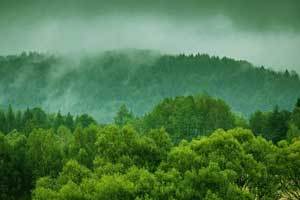
This is not just limited to oceans, though. The rainforests of Central Africa and South America are also examples of vegetation influencing the climate. Often called the "lungs of the planet," they absorb carbon dioxide (a greenhouse gas that contributes to global warming) while releasing oxygen at the same time. It plays a huge role in stabilizing the climate.
Climate has just as strong an influence on vegetation. The subzero temperatures in the Arctic Regions make the growth and survival of vegetation impossible. Likewise, the extremely high temperatures and dry air over the deserts of Northern Africa and the Arabian Peninsula also renders the existence of any vegetation impossible.
This is an important subject and will be covered in a separate article but needed to be mentioned here, simply due to its relevance and importance.
96) Climate And Geography
A connection between geography and its influence on climate has been made as far back as Ancient Greek times when Pythagoras contemplated the idea, which was later expanded on by Aristotle.
Over the course of time, we established that there are four main geographical factors that influence the climate in a significant way.
Latitude: Temperatures are normally the warmest at the tropics and start dropping the further you move away from them.
Bodies Of Water: The water in oceans and lakes don't heat up that quickly and also do not cool down fast at well. This has an effect on areas surrounding oceans and lakes, moderating the temperature and create fewer extremities and fluctuations in the climate.
Topography: The physical terrain covering a specific area can play a huge role in how the climate behaves in that area. Valleys, hills, a smooth or rocky terrain, and canyons - all play a part in determining the local climate.
Elevation: It is well-known that temperature decreases as altitude increases. Although a multitude of other factors influences climate in any specific area, a region located at a much higher altitude than one situated at sea level will display a clear difference in atmospheric condition based on the difference in altitude alone.
97) Climate Change And Heat
The biggest noticeable result of climate change is the rise in global temperatures. We are experiencing more hot days than cold days on an increasingly frequent basis across the globe.

Across the United States, record daily high temperatures were double the amount of record daily low temperatures during the course of the last decade.
This global tendency can have a snowball effect, as increased temperatures can lead to drought, which in turn can lead to even warmer temperatures.
The increase in heat can lead to a variety of threats, too numerous to explain in detail. Some of the areas that will be affected include health, energy demands, and agriculture.
98) Climate Change And Rainfall
Apart from many other weather phenomena showing evidence of climate change, the increase in rainfall and flooding has been particularly noticeable in many countries.
It is not that hard to make the connection. Around 60% of global rainfall comes from the world's oceans, while 40% is "recovered" from the continents.
As the planet is getting hotter and we experience warmer days, an increase in evaporation of water occurs. Combined with the warmer air's capacity to hold much more water vapor, it leads to the increase in precipitation and flooding we are experiencing.
99) Climate Does Have An Effect On Life Expectancy
In regions around the world normally experiencing very cold climates, a clear correlation between early deaths and colder climates has been shown. In the United States alone, the number of deaths as a result of cold weather is around 27 940 (1.3%).

As I already pointed out in other articles, cold weather causes the body to spend a lot more energy in an attempt to stay warm. (Shivering from the cold is nothing more than rapid muscle contractions initiated by the body's immune system to warm the body up.)
People with a weak or compromised immune system, like the elderly, may not be able to produce and maintain this type of energy to maintain body temperatures during extremely cold conditions. This may cause the body's immune system to shut down and can be fatal.
100) Climate Is Not Weather
They may be observing the same weather variable like temperature, rainfall, air pressure, and humidity. But at their core, climate and weather differ in some fundamental ways.
In a nutshell, climate refers to average atmospheric conditions, as well as changes in the state of the earth's atmosphere, measured over a period of at least thirty years or more.
This includes global changes in temperature, the flow of our oceans' currents, and rainfall, to mention a few variables.
Weather measures all these atmospheric changes in real-time and over a short period of time, and use existing and historical data to make weather forecast a few days in advance.
This means climate measures weather conditions over months/years and determine long-term weather tendencies, while the weather does it over a short period of time.
Read more about the difference between weather and climate in this article.
101 Never Stop Learning
We live in fascinating times, where the climate is changing almost as fast as the technology that drives our weather systems.
There will always be some new or better weather station coming out, new ways of predicting weather will be developed. Even our whole understanding of weather systems and how to interpret it may be challenged, and we may be forced to adapt.
Don't be scared of these changes that may come, in whichever form. Embrace it and learn to adapt to it. As I said, we live in exciting times.
Conclusion
I seriously doubt whether you were able to read through this rather "lengthy post." If you did, I take my hat off to you.
The whole idea of this 101 Weather Information article was to let you skim through the different sections and topics. I tried to include a little bit of everything for you. From useful hints and tips, valuable information, to just some very rare and unknown facts about our planet's wonderful and unpredictable weather.
Maybe you found something that piqued your interest. Maybe you just enjoyed learning something new. Or maybe you stumbled across an answer to a question you have been asking yourself for ages.
Whatever the case, I just hope you found these 101 tips and information interesting and helpful. You can keep on using this post for future reference when looking to explore new ideas, or simply just to pass the time.
Never miss out again when another interesting and helpful article is released and stay updated, while also receiving helpful tips & information by simply clicking on this link .
Until next time, keep your eye on the weather!
Wessel
